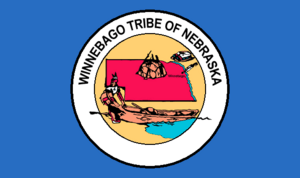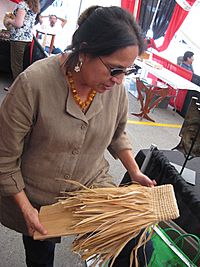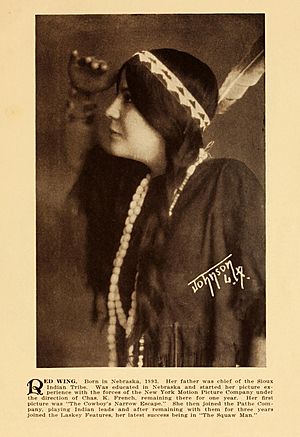Winnebago Tribe of Nebraska facts for kids

Tribal Flag
|
|

Enrolled tribal member Martha Gradolf, a weaver
|
|
| Total population | |
|---|---|
| 4,192 | |
| Regions with significant populations | |
| Languages | |
| English, Ho-Chunk | |
| Religion | |
| traditional tribal religion, Native American Church | |
| Related ethnic groups | |
| other Ho-Chunk people, Otoe, Iowa, and Missouria people |
The Winnebago Tribe of Nebraska (Ho-Chunk: Nįįšoc Hoocąk) is one of two federally recognized tribes of Ho-Chunk people. A federally recognized tribe is an Indigenous group that has a special government-to-government relationship with the United States. The other recognized Ho-Chunk tribe is the Ho-Chunk Nation of Wisconsin.
Members of the Winnebago Tribe often call themselves Hochungra. This means "People of the Parent Speech" in their own language. Their language, called Ho-Chunk, is part of the Siouan language family.
Contents
The Winnebago Tribe's Home: The Reservation
The Winnebago Tribe of Nebraska lives on the Winnebago Reservation. This special area was set aside for them by a treaty on March 8, 1865. A treaty is a formal agreement between two or more groups, like a tribe and a government.
The reservation is located in Thurston and Dixon counties in Nebraska. It also extends into Woodbury County, Iowa. The total area of the reservation is about 176.55 square miles (457.27 square kilometers). A large part of this land is held in trust by the tribe. In 1990, over 1,100 tribal members lived on the reservation.
Language and Culture
The Winnebago Tribe speaks both English and the Ho-Chunk language (Hocąk). Ho-Chunk is a unique language. It belongs to the Western Siouan languages group. This group is part of the larger Siouan-Catawban language family. Learning and speaking Ho-Chunk helps keep the tribe's culture and history alive.
Building a Strong Future: Economic Development

The Winnebago Tribe works hard to create a strong economy for its people. They have a successful business called Ho-Chunk, Inc.. This company offers many services. These include construction, professional services, and various products for businesses and people.
The tribe also owns and runs the WinnaVegas Casino Resort. This resort includes a hotel and restaurants like Flowers Island Restaurant and Buffet. These businesses are located in Sloan, Iowa.
Ho-Chunk, Inc. has received awards for its excellent management. The Harvard Project on American Indian Economic Development has recognized them multiple times. They won the Honoring Nations award in 2000, 2002, 2006, and 2015. These awards celebrate tribes that show great leadership and solve challenges in creative ways.
Supporting Young People: Juvenile Services
The Winnebago Tribe cares deeply about its young people. They have worked with the Nebraska Crime Commission to create a plan for youth safety. This plan helps prevent crime and supports young tribal members.
The "Winnebago Tribe of Nebraska Comprehensive Juvenile Services Plan" focuses on three main goals:
- Making sure everyone in the community helps support and guide young people.
- Improving how the community works together.
- Creating a better and more organized system for youth justice.
In 2012, the Winnebago Juvenile Justice Planning Team (WJJPT) was formed. This team helps connect with youth and improve public safety. The WJJPT has organized many safety programs. These include outreach programs in schools and planning a Crisis Intervention Center.
Famous Winnebago Tribal Members
Many talented people are members of the Winnebago Tribe. Here are a few notable individuals:
- Joba Chamberlain (born 1985) was a Major League Baseball pitcher. He played from 2007 to 2016.
- Henry Roe Cloud (1884–1950) was an important educator and administrator. He was the first full-blood Native American to attend Yale College. He also worked for the U.S. federal government and was a Presbyterian minister.
- Angel De Cora (1871–1919) was a gifted artist and educator. She also worked as an activist for Native American rights.
- Terri Crawford Hansen (born 1953) is a respected journalist.
- Frank LaMere (1950–2019) was a dedicated activist and politician.
- Lexie Wakan LaMere (1992–2014) was Frank LaMere's daughter. She was the first Native person to graduate from Senate Page school. She was also the youngest delegate in the Nebraska Democratic Party.
- Renya K. Ramirez (born 1959) is an anthropologist and author. She is known for her work on Native feminist topics.
- John Raymond Rice (1914–1950) served in the U.S. Army. He fought with UN Forces during the Korean War.
- Reuben Snake (1937–1993) was a leader in the American Indian Movement. He also served as chairman of the Winnebago Tribe and later as president of the National Congress of American Indians.
- Lillian St. Cyr, known as Red Wing (1884–1974), was an actress. She was famous during the silent film era.

